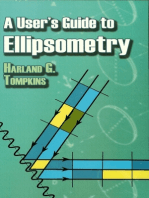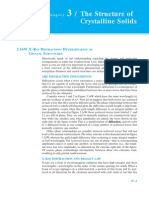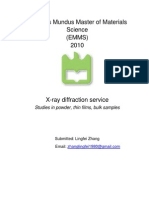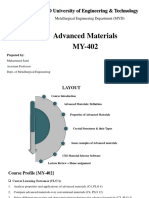Principle of Photo Electron Spectros
Principle of Photo Electron Spectros
Uploaded by
Abdul BaasitCopyright:
Available Formats
Principle of Photo Electron Spectros
Principle of Photo Electron Spectros
Uploaded by
Abdul BaasitOriginal Title
Copyright
Available Formats
Share this document
Did you find this document useful?
Is this content inappropriate?
Copyright:
Available Formats
Principle of Photo Electron Spectros
Principle of Photo Electron Spectros
Uploaded by
Abdul BaasitCopyright:
Available Formats
Photoelectron Spectroscopy --- Basics 1.1 Photoemission process (Ref. 3.1, P.
43)
When a sample surface is irradiated with photons of energy h, electrons are emitted from the sample surface. Figure 1.1.1 shows the essence of this photoemission process.
Fig. 1.1.1 Photoemission process.
This process was first reported by H.Hertz in 1887. The excitation source was a UV lamp. Nowadays, the excitation source can be X-ray or synchrotron radiation. In this module, we concentrate on the X-ray photoelectron spectroscopy. Reference: 3.1 J. C. Vickerman, Surface analysis the principal techniques, John Wiley & Sons (1997).
Goto: Section 1.2 Surface Sensitivity of XPS or Section 1.3 History of photoelectron spectroscopy
1.2 Surface Sensitivity of XPS (Ref. 3.1, P. 58-61)
Photoelectron spectroscopy is a surface sensitive technique. Its surface sensitivity can be explained in terms of the inelastic mean free path of electrons, .
Photoelectron Spectroscopy --- Basics
Inelastic mean free path is defined as the distance traveled by an electron between successive inelastic collisions. When the energy of the electron is larger than 100 eV, the higher the kinetic energy of the electron the longer the inelastic mean free path.
Fig. 1.2.1 Inelastic mean free path of electron at different energies. (M. P. Seah, and W. A. Dench, Surface and Interface analysis 1, 2 (1979).)
When X-ray photons enter below a sample surface, photoelectrons (or photoinduced electrons) are produced. Some travel out from the surface without losing any energy. Some of them lose energy owing to inelastic collisions.
Photoelectron Spectroscopy --- Basics
Fig. 1.2.2 Electrons from the sample surface.
Photoelectron Spectroscopy --- Basics
It has been shown theoretically by a Monte Carlo simulation and proved 2 experimentally that the intensity of ejecting electrons through a medium with no energy loss will follow an exponential decay function, i.e.
d x I (d ) = K exp 0 cos
dx
1 C. J. Powell, A. Jablonski, S. Tanuma and D. R. Penn, J. Electron Spectrosc. Relat. Phenom, 68, P.605 (1994). 2 D. F. Mitchell, K. B. Clark, J. A. Bardwell, W. N. Lennard, G. R. Massoumi and I. V. Mitchell, Surf. Interface Anal. 21, P.44 (1994). Fraction of signal from various depth in term of Equation Fraction of signal (assuming is 0) 0.63 x 1 from surface exp( )dx I ( ) 0 cos = x I ( ) 0 exp( cos )dx 2 0.86 x 2 from surface exp( )dx I (2 ) 0 cos = x I ( ) 0 exp( cos )dx 3 0.95 x 3 from surface exp( )dx I (3 ) 0 cos = x I ( ) 0 exp( cos )dx Depth Thus 95% of the photoelectron signals come from the surface region of 3 thick. (3 is about several tens of ). The remaining 5% of signals come from the deeper region. This explains the surface sensitivity of XPS. Activities on web: Visit http://www.lasurface.com/IMFP/Ag_IMFP_1.htm You can learn why XPS is a surface sensitive technique in this website. Also, try the program at http://www.lasurface.com/IMFP/Ag_IMFP_3.htm to calculate the inelastic mean free path. The site is created with the help of VG Scientific. Question: "The penetration depth of X-ray used in XPS is in the order of m, therefore the surface sensitivity of XPS is restricted to analysis in m level."
Photoelectron Spectroscopy --- Basics
Please comment upon the above statement. Is it true or false? Answer with appropriate argument based on the origin of the surface sensitivity of XPS in terms of the inelastic mean free path of electron, , and the exponential decay function of photoelectron from within the sample. Reference: 3.1 J. C. Vickerman, Surface analysis the principal techniques, John Wiley & Sons (1997).
Goto: Section 1.3 History of photoelectron spectroscopy
1.3 History of photoelectron spectroscopy (Ref. 3.1, P. 44-46)
1.3.1. Photoemission in the Pre-Siegbahn period 1887: Heinrich Hertz published, "On an effect of UV light upon the electric discharge" (Sitzungsber d. Berl. Akad. d. Wiss., June 9, 1887). 1895: Discovery of X-rays by W.K. Rntgen. 1897: J.J. Thomson's cathode ray tube experiments for measuring e/m of electrons: a primitive electron spectrometer. 1905: Einstein equation for the photoelectric effect: eV0 = h .
Fig. 1.3.1 Lenards apparatus for investigating the photoelectric effect.
Photoelectron Spectroscopy --- Basics
Fig. 1.3.2 The variation of the photoelectric current with voltage, for different intensities of light, A<B<C. 1907: Innes, a Ph.D. student, conducted research on: "....the velocity of the cathode particles emitted by various metals under the influence of Rntgen rays...." (Proc. Roy. Sec.. Ser. A 79, 442(1907)). A photographic plate was used to measure the deflection of photoelectrons in a magnetic field. 1918: First XPS paper by a Chinese(!) A Harvard University researcher, Mang-Fuh Hu, reported, "some preliminary results in a determination of the maximum emission velocity of the photoelectrons from metals at X-ray frequencies" (Phys. Rev. 11, 505(1918)). 1925: H. Robinson, a pioneer who devoted his entire research career to XPS, wrote that, "...an accurate knowledge of the energies associated with the different electronic orbits within the atoms is essential to the further development of the theory of atomic structure" (Proc. Roy. Sec., Ser. A, 104, 455(1923)).
Reference: 3.1 J. C. Vickerman, Surface analysis the principal techniques, John Wiley & Sons (1997).
Goto: Section 1.3.2 Developments in Quantum Mechanics in the Pre-Siegbahn period
Photoelectron Spectroscopy --- Basics
1.3.2 Developments of Quantum Mechanics in the Pre-Siegbahn period 1911: Rutherford backscattering experiment for probing atomic structures. 1913: Bohr's primitive atom model. 1925: Schrdinger's quantum mechanics.
Fig. 1.3.3 Energy diagram of atomic hydrogen
Photoelectron Spectroscopy --- Basics
Fig. 1.3.4 Orbital wavefunction of Schrdinger's equation for a hydrogen atom Reference: 3.1 J. C. Vickerman, Surface analysis the principal techniques, John Wiley & Sons (1997).
Goto: Section 1.3.2 Modern Photoemission Spectroscopy
1.3.3 Modern Photoemission Spectroscopy 1950: R.G. Steinhardt Jr. published his PhD thesis, "An X-ray photoelectron spectrometer for chemical analysis" (Leihigh University). He was also the first to recognize that "X-ray photoelectron spectra are profoundly influenced by the chemical and physical nature of the surface under investigation" (Anal. Chem. 25, 697(1953)).
Photoelectron Spectroscopy --- Basics
1954: Kai Siegbahn built his high resolution photoelectron spectrometer, and subsequently established XPS as an important research and analysis tool. (Figure 3.2.2 from K. Siegbahn, C. Nordling, A. Fahlman, R. Nordberg, K. Hamrin, J. Hedman, G. Johnsson, T. Bergmark, S. E. Karlsson, I. Lindgren, and B. Lindberg, Nova Acta Regiae Soc. Sci. Ups. 20, 7 (1967).) In 1981: Kai M. Siegbahn was awarded the Nobel Prize for his contribution to the development of high-resolution electron spectroscopy. (Nobel Lectures in physics (1981-1990), World Scientific Publishing Co. Pte. Ltd 1993)
Fig.1.3.5 Schematic diagram of the early X-ray source from B. Wannberg, U. Gelius, and K. Siegbahn, J. of Phys. E.Sci. Instrum. 7, 149-159 (1994). Reference: 3.1 J. C. Vickerman, Surface analysis the principal techniques, John Wiley & Sons (1997).
Goto: Section 1.2 Surface Sensitivity of XPS
You might also like
- 464OldTests Quizz SamplesDocument10 pages464OldTests Quizz Samplesmhrdd222No ratings yet
- Radiation FluentDocument65 pagesRadiation FluentmicheloneNo ratings yet
- Noyan - Residual Stress - Measurement by Diffraction and InterpretationDocument286 pagesNoyan - Residual Stress - Measurement by Diffraction and InterpretationFrancesca SiracusaNo ratings yet
- Material Characterization PDFDocument18 pagesMaterial Characterization PDFTatiana MerchanNo ratings yet
- SAXS PresentationDocument27 pagesSAXS PresentationkikujimojiNo ratings yet
- Polarization by ScatteringDocument3 pagesPolarization by ScatteringJoe BalaNo ratings yet
- XPS IntroDocument35 pagesXPS IntroquzalbashNo ratings yet
- Synthesis and Characterization of Novel Electrode Materials For High-Performance SupercapacitorsDocument158 pagesSynthesis and Characterization of Novel Electrode Materials For High-Performance Supercapacitorsmobassher01866044145No ratings yet
- XRD BasicsDocument5 pagesXRD Basics777894292No ratings yet
- AFMDocument15 pagesAFManjali100% (1)
- Surface ChemistryDocument137 pagesSurface ChemistryMohammed86% (7)
- SINTERINGDocument12 pagesSINTERINGsuranjana26No ratings yet
- Characterization of NanomaterialsDocument75 pagesCharacterization of NanomaterialsAbhishek SharmaNo ratings yet
- Lecture 8 XPSDocument62 pagesLecture 8 XPSarulmuruguNo ratings yet
- Mems & NemsDocument21 pagesMems & NemsNarayanaNo ratings yet
- Characterization of NanomaterialsDocument21 pagesCharacterization of NanomaterialsGauri Deshmukh KaranjgaokarNo ratings yet
- XPS (X Ray Photoemission Spectroscopy) /ESCA (Electron Spectroscopy For Chemical Analysis)Document46 pagesXPS (X Ray Photoemission Spectroscopy) /ESCA (Electron Spectroscopy For Chemical Analysis)Serdar ArıcanNo ratings yet
- A Short Introduction To Free Electron Lasers: The Cern Accelerator SchoolDocument45 pagesA Short Introduction To Free Electron Lasers: The Cern Accelerator SchoolHorenhop DolakovNo ratings yet
- Density of States - Derivation PDFDocument5 pagesDensity of States - Derivation PDFsarathsrnairNo ratings yet
- Fesem Info EngDocument5 pagesFesem Info Engmanojkumaar647No ratings yet
- Nano CharacterisationDocument319 pagesNano CharacterisationRoshan JacobNo ratings yet
- Antiferromagnetic MaterialsDocument3 pagesAntiferromagnetic MaterialssamarthNo ratings yet
- Field EmissionDocument6 pagesField Emissionle_fridaNo ratings yet
- Composite MaterialsDocument30 pagesComposite Materialsarvindvsk23No ratings yet
- Ellipsometry: Alborg NiversityDocument138 pagesEllipsometry: Alborg Niversityanju guptaNo ratings yet
- Chapter 3 SolidDocument59 pagesChapter 3 Solidatikah roshanNo ratings yet
- Unit 4 - Microwave Engineering - WWW - Rgpvnotes.inDocument16 pagesUnit 4 - Microwave Engineering - WWW - Rgpvnotes.inPranav ChaturvediNo ratings yet
- Polymer in Energy Storage and GenerationDocument2 pagesPolymer in Energy Storage and GenerationUmer MahmoodNo ratings yet
- Raman SpectrosDocument8 pagesRaman SpectrosVarnakavi Naresh100% (1)
- Neutron ScatteringDocument22 pagesNeutron Scatteringhimadrisahu88No ratings yet
- Neutron DiffractionDocument30 pagesNeutron DiffractionJaba PriyaNo ratings yet
- Applied Physics Presentation: Topic:-Laser and Its ApplicationsDocument14 pagesApplied Physics Presentation: Topic:-Laser and Its ApplicationsVishal ShandilyaNo ratings yet
- EllipsometryDocument25 pagesEllipsometryViji VijithaNo ratings yet
- Meissner EffectDocument3 pagesMeissner Effectsuba lakshmiNo ratings yet
- Ruby LaserDocument10 pagesRuby LaserSadik GosaripalliNo ratings yet
- Internship Report - Lingfei ZhangDocument41 pagesInternship Report - Lingfei ZhangZhang LingfeiNo ratings yet
- Physics of Light and Optics, J. Peatross, M. Ware, ByU (2010)Document339 pagesPhysics of Light and Optics, J. Peatross, M. Ware, ByU (2010)Liz CloosNo ratings yet
- Optical Properties of SemiconductorsDocument66 pagesOptical Properties of SemiconductorsCarolina UntilaNo ratings yet
- Pengantar Teknologi Biomedik: Intro To Biomedical EngineeringDocument37 pagesPengantar Teknologi Biomedik: Intro To Biomedical EngineeringZhafir Naufal0% (1)
- ★★Electron RF Linacs for Industrial Applications - ICABU11 - 17 - 포스텍Document34 pages★★Electron RF Linacs for Industrial Applications - ICABU11 - 17 - 포스텍KoseokhoNo ratings yet
- RAMAN SPECTROSCOPY Near-InfraredDocument6 pagesRAMAN SPECTROSCOPY Near-InfraredruskaNo ratings yet
- X-Ray Photoelectron Spectroscopy (XPS) : Electron Spectroscopy For Chemical Analysis (ESCA)Document24 pagesX-Ray Photoelectron Spectroscopy (XPS) : Electron Spectroscopy For Chemical Analysis (ESCA)Jatin DarveNo ratings yet
- Particle Accelerators:: Erik Adli, University of Oslo, August 2015, @cern - CH, v2.11Document36 pagesParticle Accelerators:: Erik Adli, University of Oslo, August 2015, @cern - CH, v2.11DoKisameNo ratings yet
- 10 X-Ray DiffractionDocument8 pages10 X-Ray DiffractionProf.Dr.Mohamed Fahmy Mohamed Hussein100% (1)
- Superconductivity, Superconducting Materials and AplicationsDocument8 pagesSuperconductivity, Superconducting Materials and Aplicationsgabriel_oltean09No ratings yet
- Nanotechnology Lesson For MS StudentsDocument6 pagesNanotechnology Lesson For MS StudentssavithatssNo ratings yet
- Polymer MaterialsDocument18 pagesPolymer MaterialsZakariya ZubairNo ratings yet
- Intro To Neutron ScatteringDocument191 pagesIntro To Neutron ScatteringEleni MitsiNo ratings yet
- Piezo Electric Energy HarvestingDocument16 pagesPiezo Electric Energy HarvestingjcvmanalelNo ratings yet
- MultiferroicsDocument21 pagesMultiferroicsprashantitbhushahi100% (3)
- TEM Lecture CrystallineDocument30 pagesTEM Lecture CrystallineSyed Abdul AhadNo ratings yet
- Seminar Title On: Atomic Force Microscopy (AFM) : Netaji Subhas Institute of TechnologyDocument25 pagesSeminar Title On: Atomic Force Microscopy (AFM) : Netaji Subhas Institute of TechnologyvarunNo ratings yet
- Thin FilmsDocument9 pagesThin Filmshareesh13hNo ratings yet
- High K DielectricDocument9 pagesHigh K DielectricAnonymous eWMnRr70qNo ratings yet
- Xps PDFDocument40 pagesXps PDFIyan MaulanaNo ratings yet
- Physics Module 4 Question Bank 2018 19Document2 pagesPhysics Module 4 Question Bank 2018 19Aman DesaiNo ratings yet
- Optical MicrosDocument15 pagesOptical MicrosDHASARAIAH SNEHA100% (1)
- Module-1 AM PDFDocument46 pagesModule-1 AM PDFbilal hasanNo ratings yet
- XRD TheoryDocument7 pagesXRD TheoryAdarta MuhNo ratings yet
- Impedance SpectrosDocument10 pagesImpedance SpectrosFabio Alejandro Gomez GomezNo ratings yet
- Design and Analysis of AlgorithmsDocument94 pagesDesign and Analysis of AlgorithmsAbdul Baasit91% (11)
- The Kunan-Poshpora TragedyDocument3 pagesThe Kunan-Poshpora TragedyAbdul Baasit100% (1)
- Twenty20 ScoresheetDocument2 pagesTwenty20 ScoresheetAbdul BaasitNo ratings yet
- The Jammu & Kashmir State Board ofDocument385 pagesThe Jammu & Kashmir State Board ofFaisal Ashraf Asmi100% (1)
- Physics II Problems PDFDocument1 pagePhysics II Problems PDFBOSS BOSSNo ratings yet
- DC Generators-I PDFDocument29 pagesDC Generators-I PDFPraneetha InumarthiNo ratings yet
- Special Purpose Motors - Large FontsDocument26 pagesSpecial Purpose Motors - Large FontsAnuradha SkaNo ratings yet
- Belajar Laravel Untuk PemulaDocument1 pageBelajar Laravel Untuk PemulasarjonoNo ratings yet
- Bifocal Add: Image Jump and Image Displacement: Basic Optics, Chapter 24Document45 pagesBifocal Add: Image Jump and Image Displacement: Basic Optics, Chapter 24PAM ALVARADONo ratings yet
- Science 10 2nd Quarter ExamDocument2 pagesScience 10 2nd Quarter ExamKenneth Rose BajeNo ratings yet
- Dgms Circular 2009Document74 pagesDgms Circular 2009Ajeet Kumar50% (2)
- Reflector AntennaDocument19 pagesReflector AntennaPrisha Singhania100% (1)
- U14L03 Light 2Document15 pagesU14L03 Light 2elyanakh19No ratings yet
- ITT American Electric LPS Micro-Watt Flood Series M18 & M18C Spec Sheet 11-80Document4 pagesITT American Electric LPS Micro-Watt Flood Series M18 & M18C Spec Sheet 11-80Alan MastersNo ratings yet
- TE Pbs8 PDFDocument2 pagesTE Pbs8 PDFJoseMiguelMenchacaRodriguezNo ratings yet
- Tutorial Optical Sources and DetectorsDocument2 pagesTutorial Optical Sources and DetectorsMir Sameer HassanNo ratings yet
- LIGHT 7 Es APARENTE MIRASOLDocument8 pagesLIGHT 7 Es APARENTE MIRASOLMirasol Aparente100% (1)
- Optical Vortex Phase Plate Application NotesDocument5 pagesOptical Vortex Phase Plate Application NotesDu RoyNo ratings yet
- EE482 F09 RadiometryOverview 2ppDocument14 pagesEE482 F09 RadiometryOverview 2pp陳鼎元No ratings yet
- Medical PhysicsDocument4 pagesMedical PhysicsmohtishimNo ratings yet
- Transmission Line ReviewDocument8 pagesTransmission Line ReviewKENNED SABANILLANo ratings yet
- Light SensorsDocument32 pagesLight Sensors0307aliNo ratings yet
- Science Light Reflection WorksheetDocument3 pagesScience Light Reflection WorksheetSuha AlgharazNo ratings yet
- Chapter 4: Waves: Knowledge OrganiserDocument1 pageChapter 4: Waves: Knowledge OrganiserMichael GalarioNo ratings yet
- Induction MachineDocument5 pagesInduction MachineRaj Kumar PatelNo ratings yet
- Stage Lighting 101 Guide - Everything You Need To KnowDocument13 pagesStage Lighting 101 Guide - Everything You Need To KnowmaxonexcelNo ratings yet
- Phy ProjectDocument26 pagesPhy ProjecttamannaNo ratings yet
- NEMA 23 1.8° Hybrid Stepper Motor CatalogDocument2 pagesNEMA 23 1.8° Hybrid Stepper Motor CatalogThành DuongNo ratings yet
- Uv / V S: Isible PectrosDocument57 pagesUv / V S: Isible PectrosTahreem FatimaNo ratings yet
- Physics Module 5 SolutionDocument48 pagesPhysics Module 5 Solutioneezypezy56734No ratings yet
- CH 332 (W15) - Quiz 1 DocumentDocument2 pagesCH 332 (W15) - Quiz 1 DocumentLaithAlkalthamAlsayariNo ratings yet




























































































